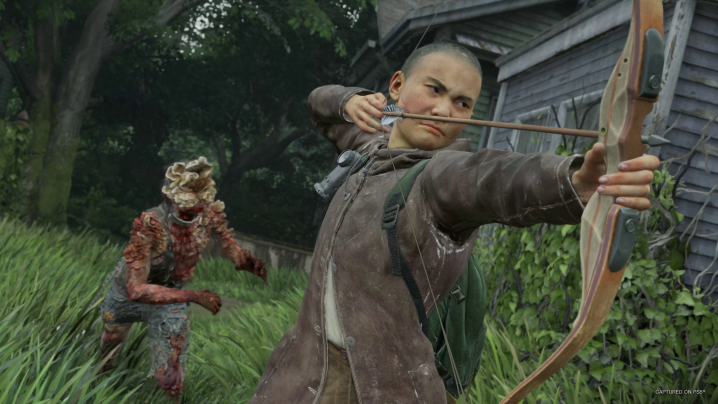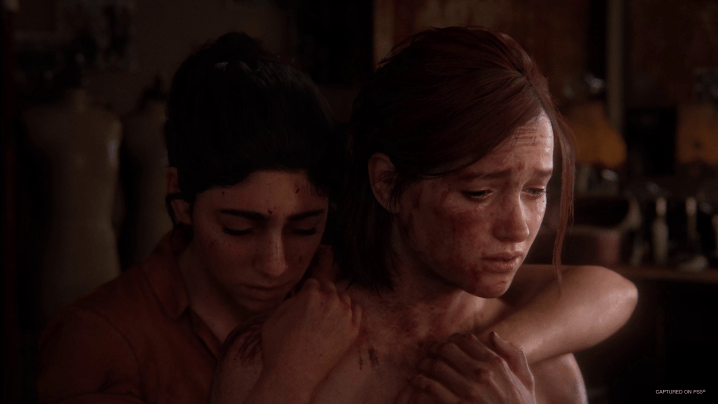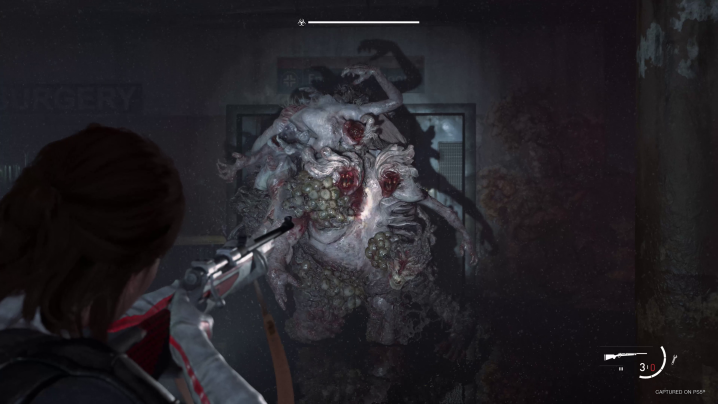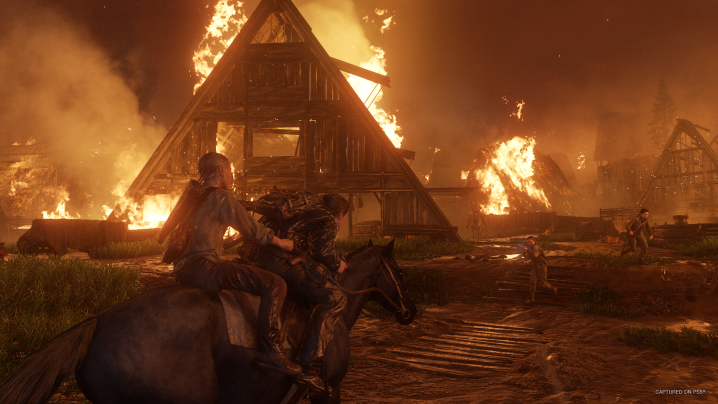
It was a sunny spring day in 2020, amid the social isolation of the COVID-19 pandemic, when I beat The Last of Us Part 2. As its long credits rolled, I paced around my small apartment living room, unpacking what had transpired. I adored the sequel’s first two acts and its multifaceted discussion of cyclical violence, but I found myself critical of its California-set finale. It seemed to backtrack on all the nuance of Ellie and Abby’s struggle by introducing a definitively evil faction that I wouldn’t feel bad about shooting with a machine gun. It was a discordant note at the end of a symphony, but I was determined to dig below my surface reading and try to understand what Naughty Dog was going for. It had earned that.
That’s when I was hit by the one moment of the game I’ll never forget. As I was deep in reflection, the credits wrapped up, and a final bit of text splashed on the screen. As a reward for finishing the brutal story, I had unlocked New Game+ mode, which would encourage me to replay it again with all my upgraded guns. The benefit of the doubt I’d given Naughty Dog went out the window; did the studio even understand its own game?
When I import my old save file in The Last of Us Part 2 Remastered, that question gets blown up in 50-point font. That familiar endgame splash screen once again pops up, but it’s now three times as absurd. I’m encouraged to blow through the story as fast as I can in a Speedrun mode and rack up kills in the rerelease’s bloody roguelike add-on, No Return. The violence must continue to keep the series relevant between long development cycles.
As a double-dip built for superfans, The Last of Us Part 2 Remastered is a fine (though inaccurately titled) collector’s edition with some valuable archival material. But as an extension of Naughty Dog’s creative vision, it’s borderline mockery that turns a thoughtful story into a cruel punch line.
Director’s cut
If you’re thinking about grabbing The Last of Us Part 2 Remastered, let’s get one thing straight: It isn’t much of a remaster. Though it does come with a visual upgrade, those changes are largely negligible. Sure, there are some slight visual enhancements and performance boosts for those who love to savor every single frame, but I’d wager that most of it won’t register with your average player. I can barely notice a difference. Even when I can, it doesn’t change my relationship to the story in any way. It’s a needless boost delivered only three years after a great-looking game’s release.
A lot of Naughty Dog’s marketing problems here would have been resolved with a subtitle change. This isn’t a remaster; it’s a director’s cut. That branding has previously been given to Death Stranding and Ghost of Tsushima’s PlayStation 5 upgrades and it’s puzzling that Sony didn’t enforce some consistency here. What you’re really buying here is the Criterion Collection rerelease of The Last of Us Part 2, complete with a full commentary track and behind-the-scenes features.

Some of those extras are worthwhile for those who simply love the base game. The hours of commentary provide some valuable insight into the story, with the voice cast and creative director Neil Druckmann breaking down the small nuances of every single cutscene. It gives players insight into why certain decisions were made, what ideas were cut, and how the actors think about the characters they portray. It’s the right kind of bonus to include with a game like this, one that underscores the detail-oriented artistic effort that makes the story so effective.
Similarly valuable is a small selection of cut content included with the packages. The trio of “lost levels” are not exciting new expansions that add more hours to the game; they only give a few minutes of gameplay total and are presented in a raw, unfinished state. One simply throws Ellie in a quick transitional space that had a few minigames planned but was cut for pacing. Its most involved one is a lost third-act introduction that has Ellie hunting down a boar and culminates in a convenience store boss fight against the rampaging pig.

It’s easy to tell why each was cut, but it’s fascinating to understand that process. Bonus commentary snippets have designers breaking down exactly how they built each level and why they were ultimately canned despite being mostly finished. It’s a level of transparency we never get in games of this scale, allowing players to see how much thought goes into even the smallest scenes. The extras are too short to justify a purchase and could have easily been a free add-on, but they’re a nice addition that celebrates the artistry of The Last of Us Part 2.
Had the package stopped there, it would have been a needless but respectful double-dip. Even the added music mode, which lets players freely toy around with the base game’s excellent guitar minigame, feels like a fitting way to highlight one of the adventure’s finest qualities. Unfortunately, developer insights and a few minutes of rough level sketches don’t equal engagement — and that’s where The Last of Us Part 2 Remastered embarrasses itself.
More violence
The main draw of the package is a new roguelike mode called No Return, which has players enduring waves of human and clicker attacks that culminate in a monstrous boss fight. If you’re the kind of person who doesn’t care how gameplay informs narrative and only cares about pure entertainment, I’ll get this out of the way early: It’s just not fun.
No Return acts as an easy content remix that takes existing assets and gameplay systems and shoehorns them into a game they were never designed around. After choosing one of several playable characters, including Joel and Lev, players are dropped into a safe room that contains a mission select board with branching paths. Each one sends them to a small level from the game and has players either killing waves of enemies or surviving an onslaught as a timer ticks down. A successful level rewards supplements and resources that can be used to upgrade guns and earn skills in each run.

It’s a very stripped-down vision of a roguelike that doesn’t play to any of the base game’s strengths. Third-person combat is complex in The Last of Us Part 2, but it’s also intentionally slow and clumsy. Each shot is meant to have weight, making players really feel the magnitude of each bullet they send into human flesh. It’s not fun; it’s a visceral and uncomfortable way to communicate the dark, animalistic place that Ellie’s quest for revenge takes her. That system sticks out like a sore thumb in an entertainment-focused roguelike mode where I occasionally get goofy modifiers that cause enemies to spontaneously combust when getting hit by a melee strike.
The undercooked mode isn’t a total waste of storage space. Naughty Dog threads in a satisfying progression system that unlocks a drip feed of characters, costumes, modifiers, and entire mechanics each run. For those who click with it, there’s enough content to chase while working toward unlocking six distinct end bosses. I can feel some of Naughty Dog’s learnings from making an ill-fated live-service game at play here through smart engagement loops. However, the thin gameplay just doesn’t hold up its end of the bargain.
The more pressing issue with No Return is how mind-bogglingly awkward it is in the context of The Last of Us Part 2. The base game is a deep meditation on cyclical violence, adapting the old “eye for an eye” saying into a grisly story. Considering that, I had hoped that Naughty Dog would perhaps use a roguelike structure to extend that idea much like God of War Ragnarok’s excellent Valhalla DLC does. What better way is there to discuss how violence moves in cycles than with a run-based roguelike that traps players in an endless stream of shootouts?

No Return does absolutely nothing with that idea. It is delivered straight, without a hint of self-awareness. There’s no narrative thread to set up a loaded premise or any packaging at all. Players simply load in, kill a whole bunch of people, unlock a funny T-shirt for their hero, and do it again. All the while, everything built to provoke discomfort in the base game remains unchanged. When I kill an enemy, an NPC still occasionally calls out their name in agony as I lodge a sickle in someone else’s stomach to restore my health via a random perk.
After spending 25 hours playing through one of the most distressing interactive meditations on violence ever made, I’m expected to put it all aside and indulge in some morbid fun. It would be comedic if it weren’t so bleak.
Reassessing a complicated story
The painfully awkward inclusion of No Return has a negative impact on the base game it’s packaged with. As I gun through waves of humans, every criticism I had with The Last of Us Part 2 bubbles back to the surface. I remember how frustrated I was by its third act, which needlessly had me killing a left-field “bad guy” faction en route to an excessive final brawl with Abby. I flash back to the humanistic ending of Abby’s chapters, which seemed like it was building toward a mature resolution about breaking away from violence — only to turn around and maim its characters one last time. Most of all, I return to that tone-deaf New Game+ integration, which has been usurped by No Return as the most embarrassing aspect of the game.
Well, maybe it’s third now. The Remastered edition’s new Speedrun mode might get the edge here. What emphasizes the teachings of The Last of Us Part 2 more than trying to go through its brutal killings multiple times in the hunt for a high score?

It certainly doesn’t help that The Last of Us Part 2 Remastered is dropping at the absolute worst possible moment. Druckmann has previously noted that his inspiration for the story came from the conflict between Israel and Palestine. A traumatic image moved him to write a story about two factions going to war with one another and destroying each other’s lives in the process. The 2020 release was removed enough from that geopolitical struggle to operate on its own terms, but it does not have the same luxury in 2024. It’s difficult to remove it from the current struggle overseas, which has reportedly left tens of thousands of Palestinian civilians — including thousands of children — dead.
The narrative is sure to be seen through that lens on its rerelease, with players reexamining its message on violence. Despite being a nuanced human conflict, parts of its preaching feel more reductive in a new context. The idea that everything exists in a moral gray zone and no side is fully right feels lacking when placed next to a real conflict where innocent civilians are labeled as future terrorists in order to justify the indiscriminate bombing of refugee camps and hospitals (commentary reveals that the purpose of the ruthless Rattler faction at the end of Part 2 is to make Ellie’s final kills feel “justified”). What once felt complex in its fictionalized safe house now feels insufficient in reality.
That makes modes like No Return even more egregious. A reflection on a very real crisis has now been burdened with engagement-baiting “content” meant to keep players hooked. Is it really so different from a Call of Duty game circa the war on terror — or, even worse, the controversial Six Days in Fallujah?

As I reflect on the failures of The Last of Us Part 2 Remastered, I think back to the ending I wish the story had gotten. The story’s most effective moment comes when Ellie and Abby finally lock horns in an abandoned movie theater. It’s a brutal battle where one person is destined to die. That is, until Abby makes the first mature decision in the game: she walks away. It’s the only way to break the cycle of violence. It’s almost the perfect ending, one that still leaves an irreparable scar on a PTSD-ridden Ellie and even keeps the door open for an inevitable sequel. That moment of wisdom goes out the window when Ellie decides to reignite the conflict and gun down more bodies in the process.
Just like a bankable IP, Ellie can’t take a break from the violence; she’s become a machine that feeds on blood. It’s the only way The Last of Us can keep churning out sequels, DLC, new modes, TV shows, and needless remasters that refuse to free us from its own violence. It’s kill, kill, kill until Part 3 steps in to explain why that’s wrong.
The Last of Us Part 2 Remastered is available on January 19 for PlayStation 5.



